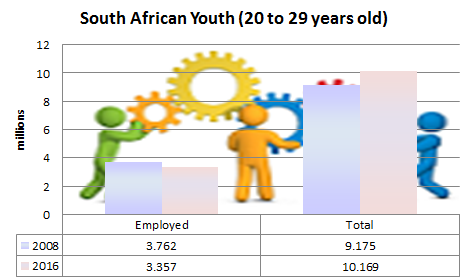

Follow us on:  
|

![High youth unemployment means young people such as these students could graduate but fail to acquire the skills or experience needed to drive the economy forward [Xinhua]](http://thebricspost.com/wp-content/uploads/2013/10/208980081_8-e1381028809917.jpg)
High youth unemployment means young people such as these students could graduate but fail to acquire the skills or experience needed to drive the economy forward [Xinhua]
National Treasury Deputy Director-General Ismail Momoniat said the Treasury was engaging with members of the National Economic Development and Labour Council (Nedlac) on the incentive, but no decision had been reached on its extension.
The wage subsidy is available for young and less skilled people aged between 18 and 29 years old earning below the personal income tax threshold.
Despite the tax incentive, youth employment for those aged between 20 and 29 years old has fallen by 10.8 per cent between the second quarter 2008 and the second quarter 2016, even though the number in this age cohort has grown by 10.8 per cent to 10.169 million, according to the Statistics South Africa Quarterly Labour Force Survey.
The youth employment tax incentive was first mooted by the Financial and Fiscal Commission in 2009 in response to the 2008 global financial crisis. It was then mentioned by the Treasury in 2010 and in 2011 Finance Minister Pravin Gordhan said he wanted the issue finalised by April 1, 2012.
The legislation to put it in place was passed in Parliament on October 24, 2013 and it became effective in January 2014.
At the time, the Treasury estimated that the youth employment tax incentive would subsidise 423,000 new jobs for youth and would cost R5 billion in tax expenditure over three years.
The experience, however, was that in the 2014-15 fiscal year, R2.6 billion ($350 million) was claimed for 686,402 jobs, while in 2015-16, an amount of R3.6 billion ($250 million) was claimed.
Data on the number of jobs supported in the last fiscal year is not yet available, as there is a lag of about 18 months to two years before reliable data is produced.
Multiple approaches to combat unemployment

Data from Stats South Africa shows that while the program exceeded forecasts, youth employment fell between 2008 and 2016
South Africa has an acute problem of youth unemployment that requires a multi-pronged strategy to raise employment and support inclusion and social cohesion.
High youth unemployment means young people are not acquiring the skills or experience needed to drive the economy forward. This inhibits the country’s economic development and imposes a larger burden on the South African government to provide social assistance.
Unemployed young people tend to be less skilled and inexperienced – almost 86 per cent do not have formal further or tertiary education, while two-thirds have never worked.
There are a number of explanations why young people are unemployed. Amongst the factors are that employers look for skills and experience; they regard unskilled, inexperienced jobseekers as a risky investment.
In addition, schooling is not a reliable signal of capabilities, and low school quality feeds into poor workplace learning capacity, which means that given the uncertainty about the potential of school leavers, employers consider entry-level wages to be too high relative to the risk of hiring these inexperienced workers.
The youth employment tax incentive therefore aimed at reducing the financial costs or risk associated with not knowing the productivity of the person to be employed. Secondly, the youth employment subsidy could help to make the training of young workers more affordable to employers, particularly smaller employers.
Thirdly, the subsidy may encourage more active job-search because youths believe that are able to find work as many are discouraged by poor job prospects.
An additional benefit is that the work experience and training gained during the period of subsidised work will improve longer-term employment prospects. It is very important to get on the first rung of the job ladder, as young people who have some work experience are over three times more likely to find another job than young people who have none.
The hope of the millions of unemployed youth is that Nedlac decides to extend the youth employment tax incentive scheme for a further three years.
Helmo Preuss in Pretoria, South Africa for The BRICS Post